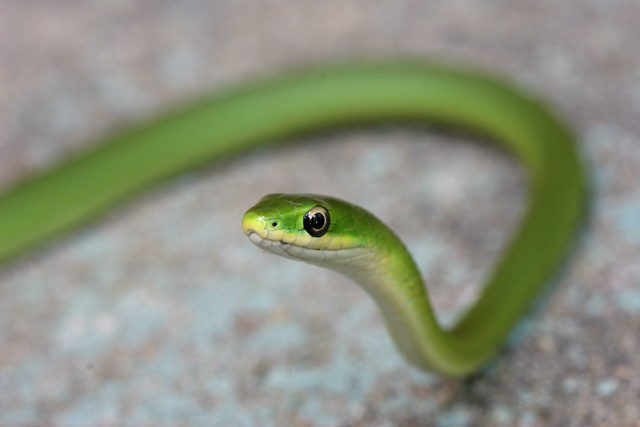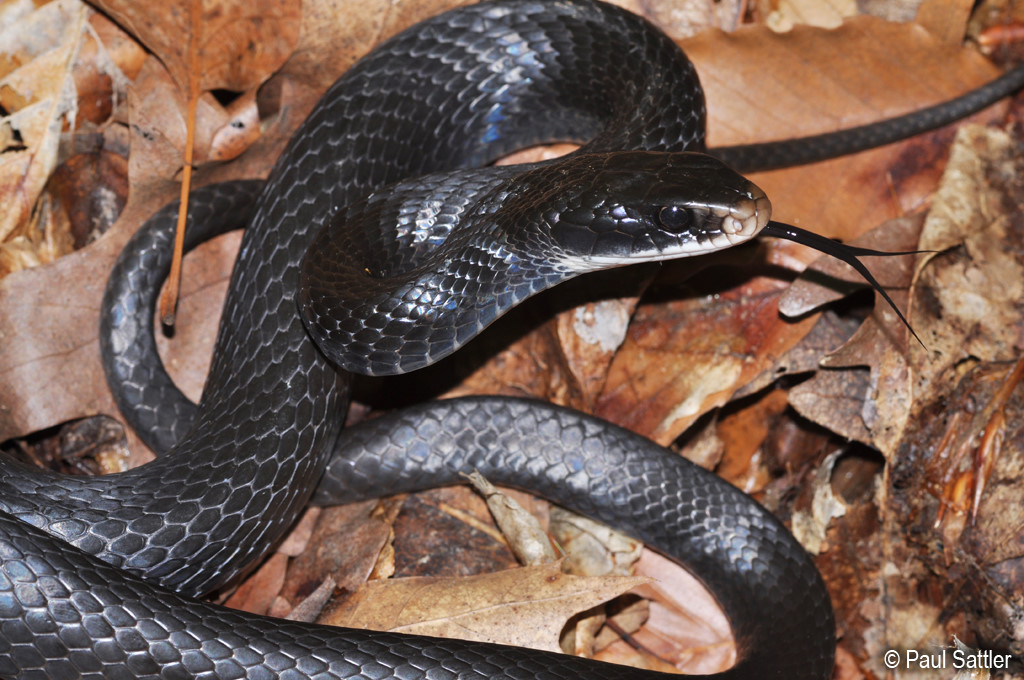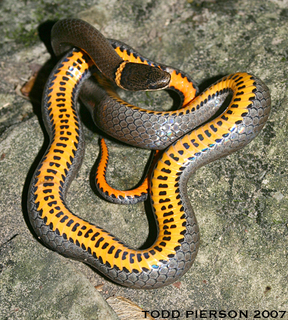 SNAKES. Of extant Eureptilia, as mentioned in the last lab, the sister to Archosauromorphs are Lepidosauromorphs. Squamata (lizards and snakes) belong to the latter. We've already explored the lizards in this group, but now it's time to talk about the snakes!
SNAKES. Of extant Eureptilia, as mentioned in the last lab, the sister to Archosauromorphs are Lepidosauromorphs. Squamata (lizards and snakes) belong to the latter. We've already explored the lizards in this group, but now it's time to talk about the snakes!Snakes have a lot of distinguishing features from lizards; since leglessness has evolved in both lizards and snakes we look at skulls and fangs.
Snake skulls articulate on the quadrate bone involving the lower jaw, making it Streptostyly. You can see the snake below actively using this jaw opening feature to ingest prey larger than it's skull:

 They also can have re-curved, evolved teeth for securing food. Some species of snakes have fangs, which have evolved independently multiple times as teeth specialized to deliver venom to prey. The major teeth and fangs are:
They also can have re-curved, evolved teeth for securing food. Some species of snakes have fangs, which have evolved independently multiple times as teeth specialized to deliver venom to prey. The major teeth and fangs are:- Aglypous (no grooves, typical re-curved teeth found in all species of snakes)
- Opisthogypous (rear-fanged - positioned on the back of the maxilla - with a conspicuous groove for delivering venom)
- Proteroglypous (front-fanged, - positioned at the front of the mouth or reduced maxilla, typically static orientation, folded and hollow in the center)
- Solenoglyphous (most-derived retractable teeth, hollow and pipe-grooved for deep venom injection - positioned on high maxilla)
Just like lizards, snake phylogeny is controversial and many hypothesizes have been proposed from morphological and behavioral data, but we work from the vantage point that 16 families have been determined. Here we looked at five families in particular.
1. Colubridae = Colubrids: 7 subfamilies
Distribution: Worldwide except for Antarctica and oceanic islands
- Characteristics: Colubrids are the most diverse paraphyletic family of snakes that includes aglyphous, opisthoglyphous and proteroglyphous taxa. Girdle and limb elements are absent externally and internally. They also lack infrared receptors.
>>Colubrinae : More than 100 genera
Distribution: Worldwide
Characteristics: Highly diverse biology and ecology, generalists and mostly oviparous.
*OHIO SPECIES:
Opheodrys vernalis (Smooth Green Snake): much of state
Opheodrys aestivus (Rough Green Snake): southern third of state
Coluber constrictor foxii (Blue Racer)
Coluber constrictor constrictor (Northern Black Racer)
Pantherophis obsoletus obsoletus (Black Rat Snake)
Pantherophis vulpina (Fox Snake)
Lampropeltis triangulum triangulum (Eastern Milk Snake)
Lampropeltis getula nigra (Black Kingsnake): southern part of state
>>Natricinae: 38 genera
Distribution: North America to northern Central America, Africa and Eurasia through the West Indies. Characteristics: Generally small and most are labeled aquatic snakes that specialize feeding on fish and amphibians (only leaving water for basking and reproduction)
*OHIO SPECIES:
Nerodia sipedon sipedon (Northern Water Snake)
Nerodia sipedon pleuralis (Midland Water Snake)
Nerodia erythrogaster neglecta (Copperbelly Water Snake)
Regina septemvittata (Queen Snake)
Thamnophis butleri (Butler’s Garter Snake)
Thamnophis sirtalis sirtalis (Eastern Garter Snake)
Thamnophis radix radix (Eastern Plains Garter Snake)
Thamnophis sauritus sauritus (Eastern Ribbon Snake)
Thamnophis sauritus septentrionalis (Northern Ribbon Snake)
Storeria dekayi wrightorum (Midland Brown Snake)
Storeria dekayi dekayi (Northern Brown Snake)
Storeria occipitomaculata occipitomaculata (Northern Redbelly Snake)
Virginia valeriae valeriae (Eastern Smooth Earth Snake)
>>Dipsadinae: over 90 genera
Distribution: Americas
Characteristics: Occur in all habitats except marine and are mostly generalist predators. These new world terrestrial snakes are also predominantly oviparous. They're also venomous but not powerful enough to do much damage to a human other than swelling.
*OHIO SPECIES:
Diadophis punctatus edwardsi (Northern Ringneck Snake)
Heterodon platyrhinos (Eastern Hognose Snake)
Carphophis amoenus amoenus (Eastern Worm Snake)
Carphophis amoenus helenae (Midwest Worm Snake)
2. Elapidae = Cobras, Kraits, Sea Snakes, Death Adders, Allies: 2 subfamilies (Elapinae:17 terrestrial genera, Hydrophiinae:43 aquatic genera)
Distribution: Southern North America to southern South America, Africa, southern Asia to southern Australia and the tropical Indian and Pacific Oceans.
- Characteristics: Elapids are venomous snakes that have and erect fang anteriorly on each maxillary bone, exemplifying proteroglypous dentation. Elapids lack infrared receptors in pits or surface indentations. The girdle and limb elements are absent externally and internally. The Elapinae are oviparous and semifossorial genera, while the Hydrophiinae are mostly aquatic with a characteristic "paddle tail".
3. Viperidae = Vipers: 3 subfamilies (Azemiopinae:1 genera, Crotalinae:26 genera, Viperinae:13 genera).
Distribution: Worldwide, except Papuaustralia and oceanic islands.
- Characteristics: Viperids are venomous snakes. They have cranial infrared receptors that occur in loreal pits in crotalines or beneath scale surfaces. Most are viviparous although some lay eggs in clutches of ten. Subfamily Viperinae lack loreal pits. Girdle and limb elements are absent externally and internally. They have distinctly triangular heads and characteristic rotating solenoglypous fangs.
(From left to right) Sistrurus catenatus catenatus (Eastern Massassauga) = Rattle, wet prairie specialists, Agkistrodon contortrix mokasan (Northern Copperhead: Mokasan) = No rattle, basal group, and Crotalus horridus (Timber Rattlesnake) = Rattle, hardwood specialists, dark tail
4. Boidae = Boas: 2 subfamilies
-Booinea:7 genera
Distribution: The subfamily Booinea is found in tropical Americas (new world)
Characteristics: They are non-venomous constrictors with a stretostyly, most have infrared labial pits and vestigal pelvic elements, and they don't have fangs. They do have spurs which are small on arboral taxa and larger on terrestrial/aquatic taxa.
-Erycinae:4 genera
Distribution: The subfamily Erycinae is found in Africa, SE Asia, and Australia (old world).
Charcteristics: They lack labial pits altogether and are semi-fossorial snakes. They are viviparous with robust cylindrical bodies, small eyes, blunt heads, and short tails. They live in arid habitats so they are mostly nocturnal.
5. Pythonidae = Pythons: Only 8 genera (Aspidites, Antaresia, Apodora, Bothrochilus, Leiopython, Liasis, Morelia, Python)
Distribution: Sub-Saharan Africa, Southern and SE Asia and Australia.
- Characteristics: They are large to giant in size and have longitudinally-oriented maxillaries and solid teeth. They have cranial infrared receptors in interlabial pits and forage above ground but some are semi-aquatic. Cloacal spurs are on hind limb vestiges of pelvic remnants and they are oviparous tending to coil around their eggs for incubation.
























Hello. This is last minute, but I'm giving a presentation on Sunday (2/21/2016) and would like to include a photo of a Copperbelly Watersnake... yours is the best I've seen. Would I be able to use your photo in the presentation? If so, please let me know how to credit the photo. Thank you!
ReplyDelete